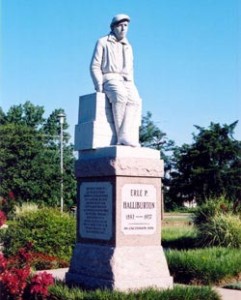For more than 100 years, nitroglycerin detonations increased a well’s production from petroleum bearing formations. Modern hydraulic fracturing technology can trace its roots to April 25, 1865, when Civil War veteran Col. Edward A. L. Roberts received the first of his many patents for an “exploding torpedo.”
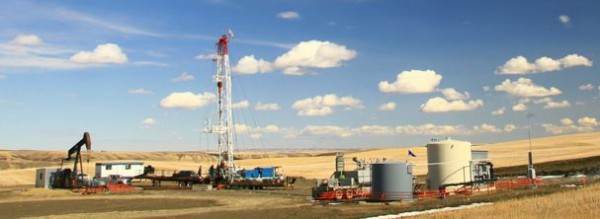
More effective -- and far safer -- than nitroglycerin, hydraulic fracturing has been used since 1949. Today, about 30 percent of U.S. oil and natural gas reserves are accessible through "fracking."
In May 1990, Pennsylvania’s Otto Cupler Torpedo Company “shot” its last oil well using liquid nitroglycerin – abandoning nitro but continuing to pursue a fundamental oilfield technology.
Although President Rick Tallini remains in the business of improving oil wells’ production, today’s fracturing systems are much advanced from Lt. Col. Edward A. L. Roberts’ original 1865-1866 patents.
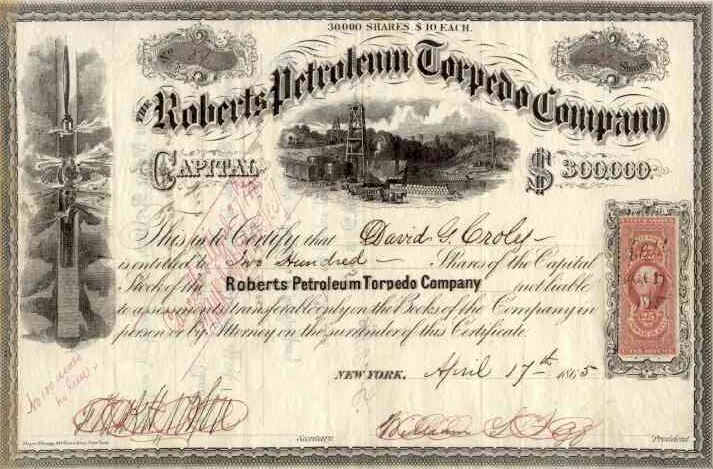
In February 1865, Col. Roberts formed the Roberts Petroleum Torpedo Company. His many patents will give him a monopoly on all types of torpedo used in the oil industry. The company stock certificate, which includes early oilfield vignettes, today is worth almost $300 to collectors.
“Our business since Colonel Roberts’ day has concerned lowering high explosives charges into oil wells in the Appalachian area to blast fractures into the oil bearing sand,” says Tallini.
Tallini’s company is based in Titusville — where the American petroleum industry began on August 27, 1859.
Today, about 30 percent of U.S. recoverable oil and natural gas reserves are accessible through hydraulic “fracking” — about seven billion barrels of oil and 600 trillion cubic feet of natural gas.
Civil War Veteran invents an Oil Well “Exploding Torpedo”
Civil War veteran Col. Edward Roberts had fought with a New Jersey Regiment at the 1862 battle of Fredericksburg, Virginia. Amidst the chaos of the battle, he had seen the results of explosive Confederate artillery rounds plunging into the narrow millrace (canal) that obstructed the battlefield.
The Virginia battlefield observation gave him an idea that would evolve into what he described as “superincumbent fluid tamping.” His revolutionary invention will greatly increase the oil and natural gas production of America’s early petroleum industry.
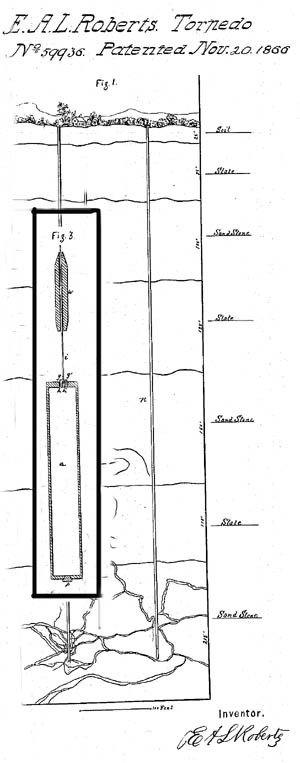
Torpedoes filled with gunpowder (later nitroglycerin) were lowered into wells and ignited by a weight dropped along a suspension wire onto a percussion cap.
Roberts was awarded U.S. Patent (No. 59,936) in November 1866 for what would become known as the Roberts Torpedo. The new technology would revolutionize the young oil and natural gas industry by vastly increasing production from individual wells.
The Titusville Morning Herald newspaper reported:
Our attention has been called to a series of experiments that have been made in the wells of various localities by Col. Roberts, with his newly patented torpedo. The results have in many cases been astonishing.
The torpedo, which is an iron case, containing an amount of powder varying from fifteen to twenty pounds, is lowered into the well, down to the spot, as near as can be ascertained, where it is necessary to explode it.
It is then exploded by means of a cap on the torpedo, connected with the top of the shell by a wire.
Filling the borehole with water provided Roberts his “fluid tamping” to concentrate concussion and more efficiently fracture surrounding oil strata. The technique had an immediate impact — production from some wells increased 1,200 percent within a week of being shot – and the Roberts Petroleum Torpedo Company flourished. Roberts charged $100 to $200 per torpedo and a royalty of one-fifteenth of the increased flow of oil.
Attempting to avoid Roberts’ fees, some oilmen hired unlicensed practitioners who operated by “moonlight” with their own devices. The inventor was outraged.
Roberts hired Pinkerton detectives and lawyers to protect his patent — and is said to have been responsible for more civil litigation in defense of a patent than anyone in U. S. history. He spent more than $250,000 to stop the unlawful “torpedoists” or “moonlighters.”
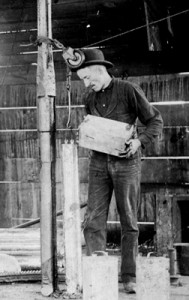
On February 5, 1873, one "moonlighter" shot his last well. Andrew J. Dalrymple died in a nitroglycerin explosion near Dennis Run, Pennsylvania. He is alleged to have been "moonlighting" -- conducting an illegal well "shot."
The term moonlighting comes from the practice of surreptitious avoidance of Roberts’ licensing fees when using his patented fracturing technique to increase production.
Applied legally or illegally, by 1868 nitroglycerin was preferred to black powder, despite its frequently fatal tendency to detonate accidentally.
“A flame or a spark would not explode Nitro-Glycerin readily, but the chap who struck it a hard rap might as well avoid trouble among his heirs by having had his will written and a cigar-box ordered to hold such fragments as his weeping relatives could pick from the surrounding district,” noted John J. McLauren in 1896 in his book Sketches in Crude Oil — Some Accidents and Incidents of the Petroleum Development in all parts of the Globe.
The Otto Cupler Torpedo Company
Roberts died a wealthy man on March 25, 1881, in Titusville. His heirs sold Roberts Petroleum Torpedo Company to its employees, who continued in business as the Independent Explosives Company.
Rick Tallini relates that the Otto Cupler Torpedo Company split off and produced its own nitroglycerin in plants near Titusville until the last plant exploded in 1978. Tallini’s company continued using liquid nitroglycerin until 1989 – when the last of the nitroglycerine supplier’s plant exploded in Moosic, Pennsylvania.
The well shooting on May 5, 1990, used up the last of Otto Cupler Company’s liquid nitro reserves.
Today, Tallini and Otto Cupler Torpedo Company continue shooting wells, but with modern explosives and rigorous safety procedures. With the advent of hydraulic and other fracking technology, shaped-charge jet perforation has become common, in which a cone-shaped charge penetrates the wells casing and cement at high velocity. Hydraulic or gas fracturing of oil-bearing formations follows.
Tallini’s historic company maintains a museum on Dottyville Road in East Titusville — preserving for future generations remarkable artifacts and documents from more than 100 years of nitroglycerin in the oilfields. The Logwell.com website also offers Tallini’s collection of historical stories that chronicle shooting wells from the Roberts day down to the present.
Editor’s Note — On April 18, 1939, Ira J. McCullough of Los Angeles received two patents for his multiple bullet-shot casing perforator “to provide a device for perforating casing after it has been installed in a well in which projectiles or perforating elements are shot through the casing and into the formation.” McCullough’s revolutionary innovation of firing at several levels through a borehole’s protective casing greatly enhanced the flow of oil. Read more in “Downhole Bazzoka.”
The Science of Hydraulic Fracturing Technology
First Commercial Application of Hydraulic Fracturing

The first commercial "Frack" takes place in 1949 about 12 miles east of Duncan, Oklahoma. By 1988, the technology will have been applied nearly one million times.
On March 17, 1949, a team of petroleum production experts converges on an oil well about 12 miles east of Duncan, Oklahoma – to perform the first commercial application of hydraulic fracturing.
Later that same day, Halliburton and Stanolind company personnel successfully fractured another well near Holliday, Texas. Another experimental well fractured two years earlier in Hugoton, Kansas – home of a massive natural gas field – had proven the possibility of increased productivity.
By 1988, the technology will have been applied nearly one million times. The technique had been developed and patented by Stanolind (later known as Pan American Oil Company) and an exclusive license issued to Halliburton to perform the process. In 1953, the license was extended to all qualified service companies.
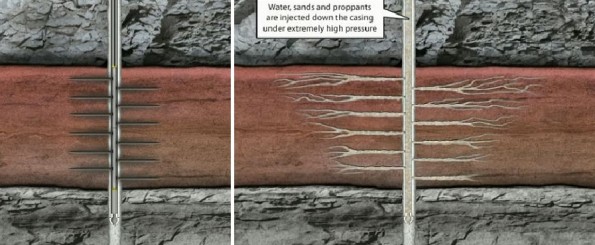
To complete a new well, explosive charges are lowered by a wire line to perforate the steel casing, cement and producing formation. After the charges are electronically fired, hydraulic fracturing greatly enhances oil and natural gas production.
According to Pinnacle, a Halliburton service company, “Since that fateful day in 1949, hydraulic fracturing has done more to increase recoverable reserves than any other technique, and Halliburton has led the industry in developing and applying fracturing technology. In the more than 60 years following those first treatments, more than two million frac(turing) treatments have been pumped with no documented case of any treatment polluting an aquifer — not one.”
Energy in Depth – Petroleum Industry defends Fracturing
“There is no shortage of questions about domestic energy production—what technologies are used? What does it mean for our environment? How does it create jobs? What is hydraulic fracturing, anyway?”
The petroleum industry has established outreach websites to educate the public about fracturing technologies. One is Energy in Depth, which includes links to the latest research studies and fact sheets. While the first commercial fracturing job was conducted in the 1940s, “the technique quickly became the most commonly used method of stimulating” wells worldwide.
“Today, hydraulic fracturing is applied to the majority of U.S. oil and natural gas wells to enhance well performance, minimize drilling, and recover otherwise inaccessible resources. In fact, roughly 90 percent of the wells in operation have been fractured — and the process continues to be applied in innovative ways to boost production of American energy in unconventional formations, such as “tight” gas sands, shale deposits and coal-beds.”
——————————————————————————————–
Col. Edward Roberts and the Battle of Fredericksburg

“We went into action under a most galling and deadly fire of shot and shell," reported Col. Edward Roberts. An 1888 lithograph depicts the Army of the Potomac crossing the Rappahannock at the Battle of Fredericksburg in December 1862.
The oilfield’s torpedo inventor Col. Edward A. L. Roberts is buried in Titusville, Pennsylvania.
A simple headstone at Woodlawn Cemetery is marked only by his name and the military rank he held at the Battle of Fredericksburg 19 years earlier.
For four months during the Civil War, the man who would someday revolutionize oil and natural gas production technology served as Lt. Colonel with the 28th New Jersey Volunteer Infantry Regiment.
Below are little-known details from service records at the National Archives, Washington, D.C.
Lt. Col. Roberts fought in the battle of Fredericksburg in December 1862 – while awaiting results from his court martial, which had convened just weeks earlier. As the military court deliberated specifications of “intoxication on dress parade,” Roberts’ regiment marched into Fredericksburg, Virginia.
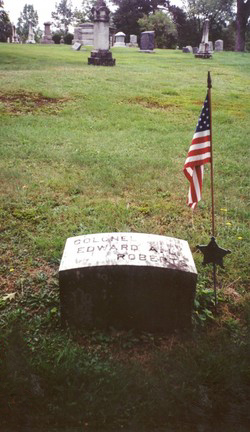
Col. Edward A. L. Roberts is buried in Titusville, Pennsylvania -- where the U.S. petroleum industry began in 1859.
On December 13, the 28th New Jersey was the center of Gen. Ambrose Burnside’s first doomed assault on the fiercely defended Marye’s Heights. Fourteen more doomed assaults would follow. The 28th charged into Gen. Robert E. Lee’s carefully positioned cannons. Confederate artillerist Col. Edward Porter Alexander had declared to Lee: “A chicken could not live on that field when we open on it.”
Alexander was right. No Union soldiers would reach Marye’s Heights that cold December day. Crossing a canal and open ground, brigade after brigade could not dislodge the Confederates from their defenses behind a sunken road and stone wall. Union casualties exceeded 12,000. When his commander was shot in the face during the 28th’s charge, Roberts assumed command.
In his after action report, Roberts wrote, “We went into action under a most galling and deadly fire of shot and shell, and continued in action until near dark. Officers and men conducted themselves well.”
A month later, Roberts’ court martial verdict was published under General Order No. 2.
Despite his actions during the battle, he was found guilty and ordered to be cashiered, effective January 12, 1863. Prior to the court’s verdict, Roberts had attempted to resign but this was strangely characterized as “tendering resignation in face of enemy.”
Roberts’ service as a Union officer was over in 1863. He would soon make history in oilfields.
———————————–
Read more about historic “oil patch” technologies.
Join the American Oil & Gas Historical Society. AOGHS is a 501 (c)-3 nonprofit program dedicated to preserving the history of U.S. petroleum exploration by providing advocacy for museums and other organizations that work to preserve that history.
Please support this energy-education mission with a donation today.

